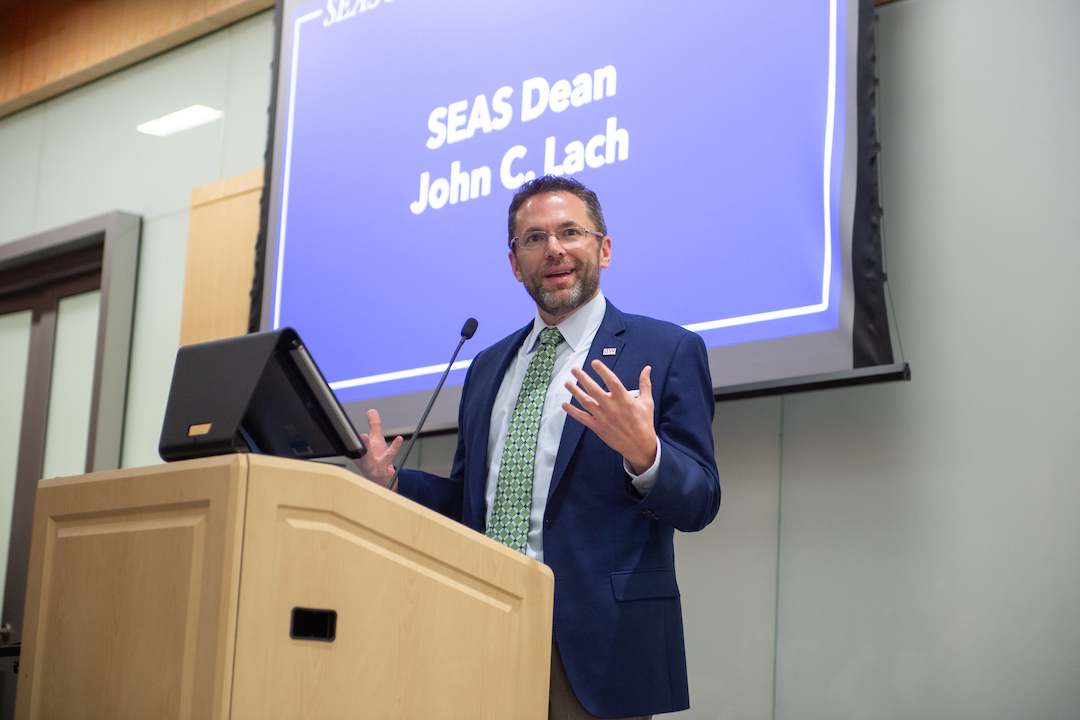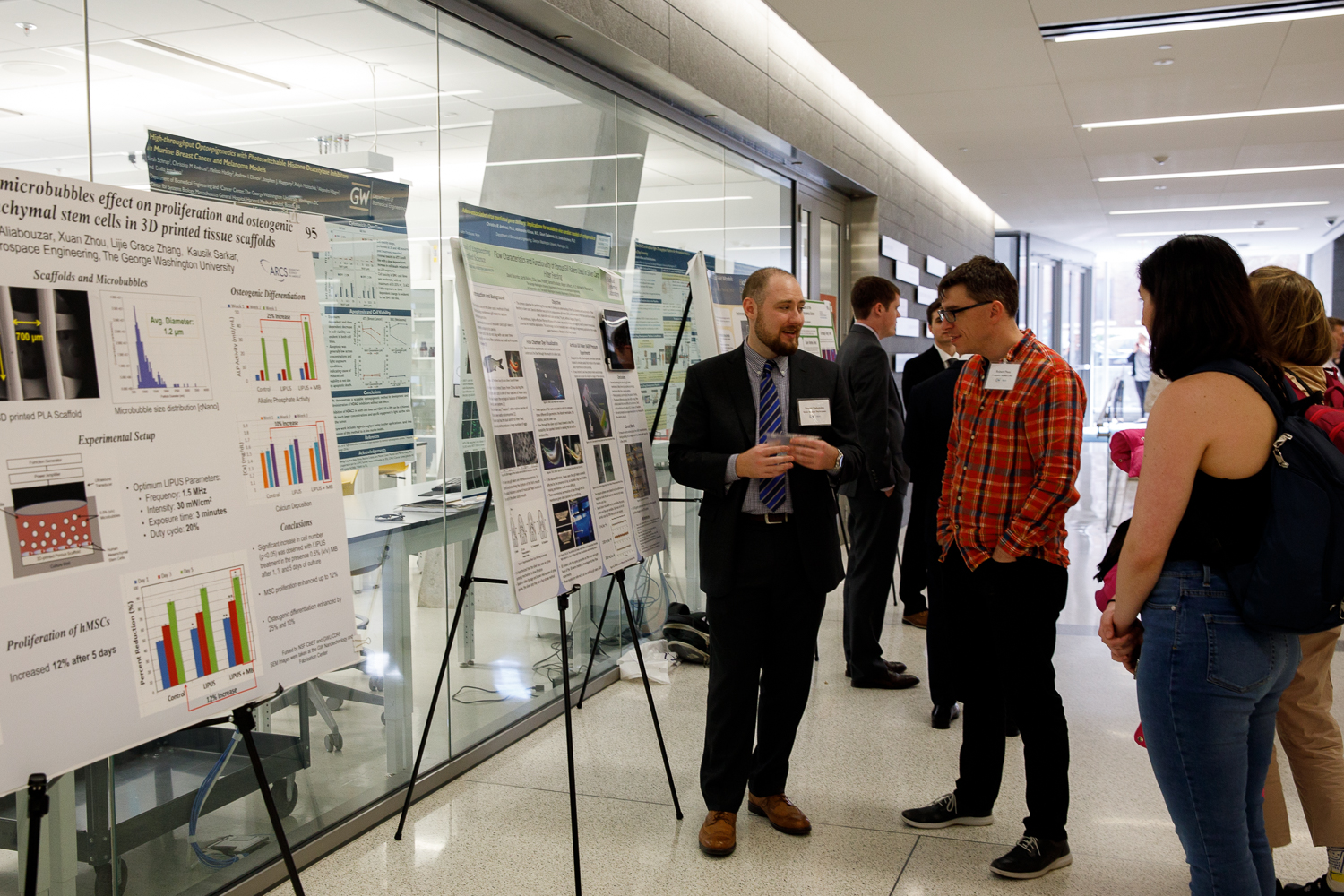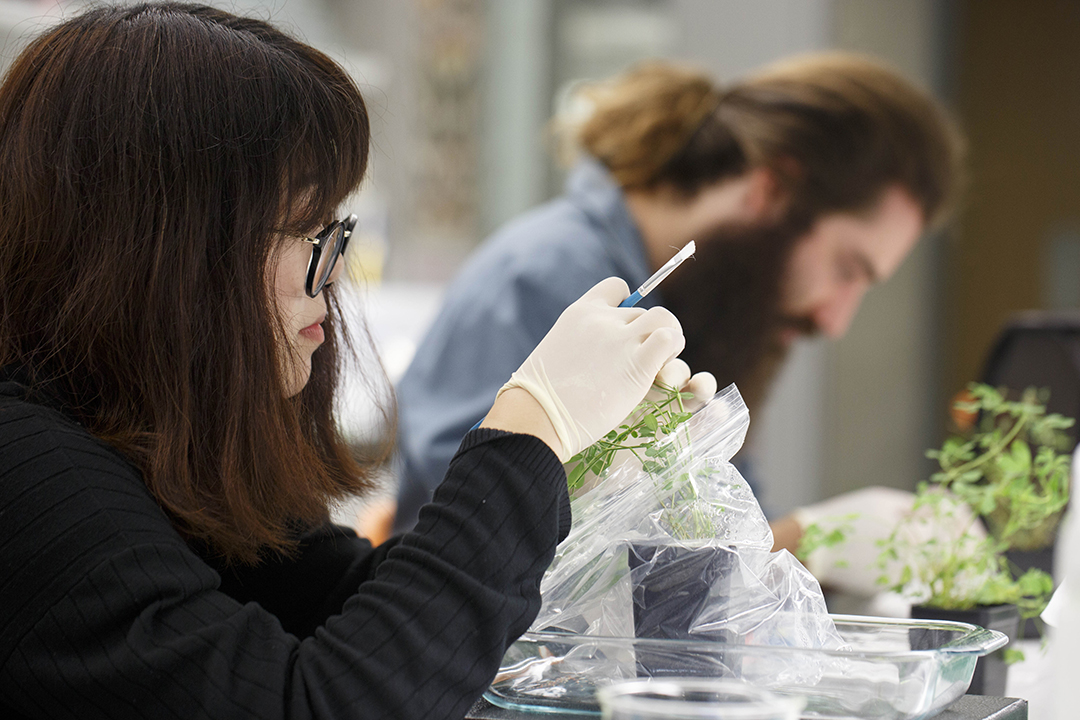By Tatyana Hopkins
Students at the George Washington University put their research on display and competed for nearly $40,000 worth of prizes Friday at the School of Engineering and Applied Science 13th annual Student Research and Development Showcase.
Almost 130 undergraduate and graduate teams exhibited posters of their work in Science and Engineering Hall for public viewing and two rounds of judging.
SEAS Dean John Lach, who began his role in August, said he was excited to host his first showcase. He thanked the faculty and alumni who acted as judges and congratulated students on their participation.
“It's such an important thing to do, to be able to communicate your work to others,” Dr. Lach said.
He also said he was happy to see a high number of interdisciplinary collaborations.
“There were so many partnerships that have been made across the various schools at this university,” Dr. Lach said. “To be at a comprehensive collocated university like GW and those opportunities that we have to work across those traditional interdisciplinary boundaries are tremendous. Being able to see those multiple school affiliations on so many posters was very exciting.”
Can Korman, SEAS associate dean of research and graduate studies, presented awards to the Showcase winners following Dr. Lach’s remarks.
Judges gave awards to the top graduate, undergraduate and runner-up teams in each of the School’s six departments.
Zacharie Day, a senior in the Department of Computer Science, was awarded the competition’s $500 Randolph A. Graves Founder’s Award for implementing a digital process for the competition’s application, poster and score submission as well as award allocation.
Additionally, 13 student teams were also awarded $3,000 AccelerateGW I-Corps Site Program Grants at the Showcase. The Accelerate GW I-Corps Site Program is funded by the National Science Foundation and managed by GW’s Office of Innovation and Entrepreneurship, and it provides grants of up to $3,000 to GW students, faculty, and staff who have great technology and want to explore the potential for commercializing it.

SEAS Dean John Lach congratulated students on their participation in the Showcase and encouraged them to continue to share their work.
Here is a sample of the research projects showcased by GW students:
Cutting Emergency Room Wait Times
Kelly N. Rickard, a doctoral student studying systems engineering and operations research, is working to help hospitals cut emergency room waiting times using mathematic programming. Her tool aligns natural patterns of patient arrivals with the admission patterns of various health care providers.
Patients are admitted to inpatient units either directly or via the emergency room departments.
Ms. Rickard found that patterns exist in inpatient arrivals that could reduce wait times. She said while hospital emergency rooms tend to be busiest on Mondays, physicians also tend to schedule elective surgeries earlier in the week.
Her program tests schedules with high, medium and low admitting physicians to find a configuration that leads to the most available beds.
She said based on her preliminary analysis, hospitals should schedule low admitters on busy days and work to maintain a consistent admission rate although more modeling is needed to give specific hospitals more specific recommendations.
“I'm hoping that by alleviating emergency department waiting, I can improve health care overall, not just locally, not just in this country, but internationally,” Ms. Rickard said.
She said emergency room crowding is an international problem that results in adverse clinical outcomes, access disparities and financial losses for the patient and the hospital, noting a study reported that patients in Saudi Arabia waited as long as one or two weeks in the emergency department.
Off-Grid Refrigerator for Natural Disasters
Alexis Renderos and Ethan Frink, sophomores studying mechanical engineering, are developing a low-cost, environmentally friendly refrigeration system that works without electricity for natural disaster-prone regions. There were advised by SEAS research professor Kartik Bulusu, D.Sc. ‘10.
“[Hurricane Dorian] left thousands in need of power due to recurring electricity cuts, and consequently that lead to challenges in refrigeration needs like medicine, vaccinations, food and clean water,” Mr. Renderos said. “We are focusing on refrigeration because what we found is when there are electricity cuts there are increased deaths dues to diabetes and sepsis.”
The team’s refrigerator will run on an ejector-based vapor compression cycle, which relies on fluid dynamics, as opposed to typical refrigerators that run by electrical compressors.
In addition to changing the mechanical operations of traditional refrigerators, the team’s project also seeks to use sustainable and environmentally friendly refrigerants as part of their cooling system.
“There are other solutions out there that do something similar,” Dr. Bulusu said. “But they rely on harmful greenhouse gasses and refrigerants. We are trying to explore through this project refrigerants that are not greenhouse contributors.”
Their work received funding from the Duke Energy Renewables Innovation Fund.
Virtual Reality for Children with Autism
Ariana Fazal, a junior studying biomedical engineering, developed virtual reality games to help doctors and physical therapists assess the motor skills of children with autism.
Ms. Fazal said children with autism often have difficulties with hand-eye coordination, movement, balance, body awareness and motor control.
The virtual reality games she developed include tossing and rolling games as well as billiards and a maze. It collects data to help physicians identify, observe and monitor children’s motor skills. The device offers a video recording of the user, a screen recording of the game and quantifies overall movement in the game.
“Observation of their motor skills can determine what treatment plan may be developed to assess their needs,” Ms. Fazal said.
She said the ultimate goal is to improve the motor skill deficits that children with autism face.
“[Virtual reality] may not be 100 percent representative of doing the same thing in real life but what we hope is that the results we get from this will help doctors and physical therapists see how far along a child's motor skills are,” she said.




